Abstract
Interactions among antineoplastic and antifungal drugs affecting the inhibition of Candida albicans growth are complex functions of the nature of the drugs used in combination, their absolute concentrations, and also their relative concentrations. Studies of drug interactions involving the use of test drugs in fixed concentration ratios can lead to inaccurate conclusions about synergism or antagonism among the drugs. A multifactorial experimental design procedure in which the concentrations of all drugs in test combinations were simultaneously varied has been used to identify and quantify drug interactions. The methods have been applied to combinations of two, three, and four drugs, including antineoplastic drugs, antifungal drugs, and combinations of antineoplastic and antifungal drugs. Results were obtained which allow predictions of effects of combinations and provide maximum effectiveness in growth inhibition with minimum levels of the test drugs.
Full text
PDF
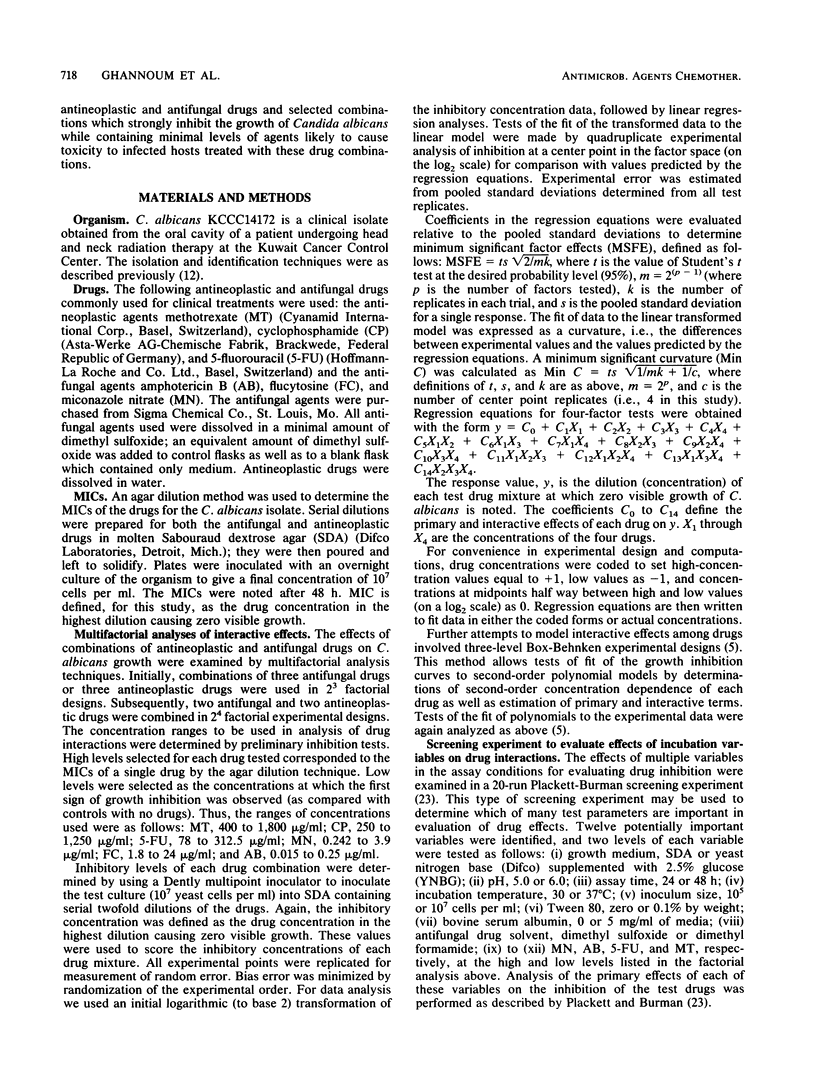
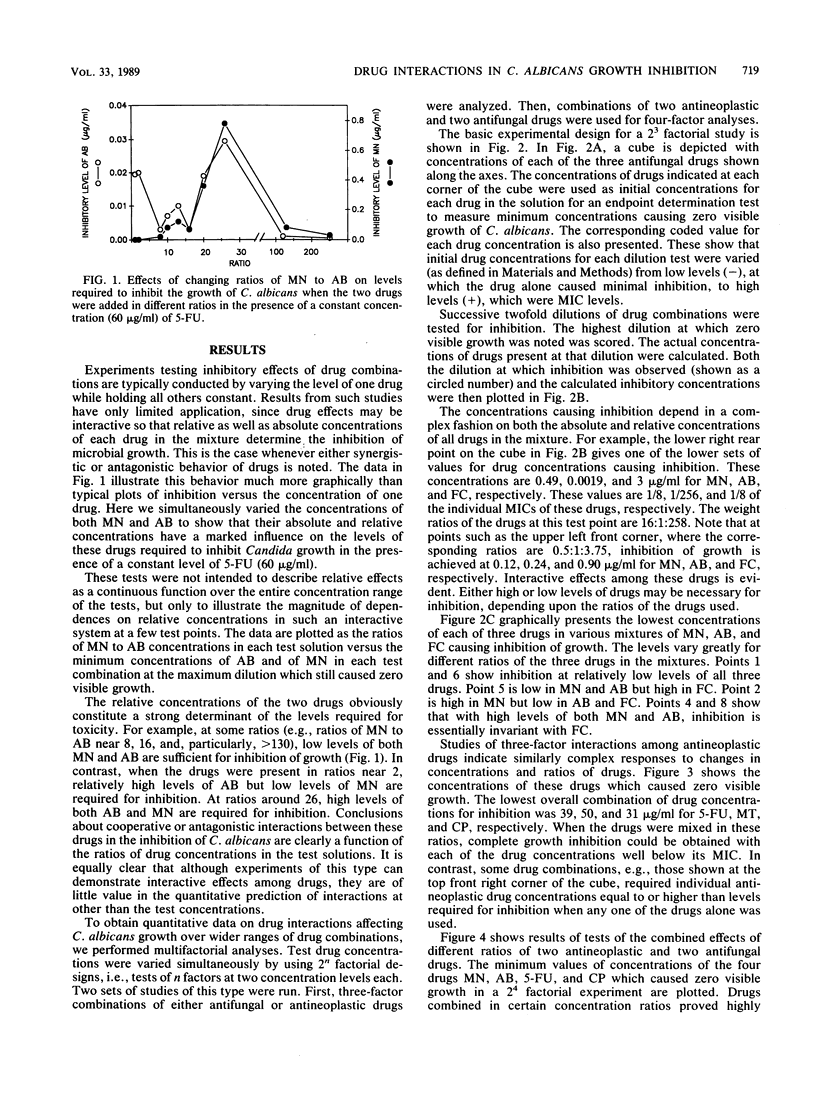

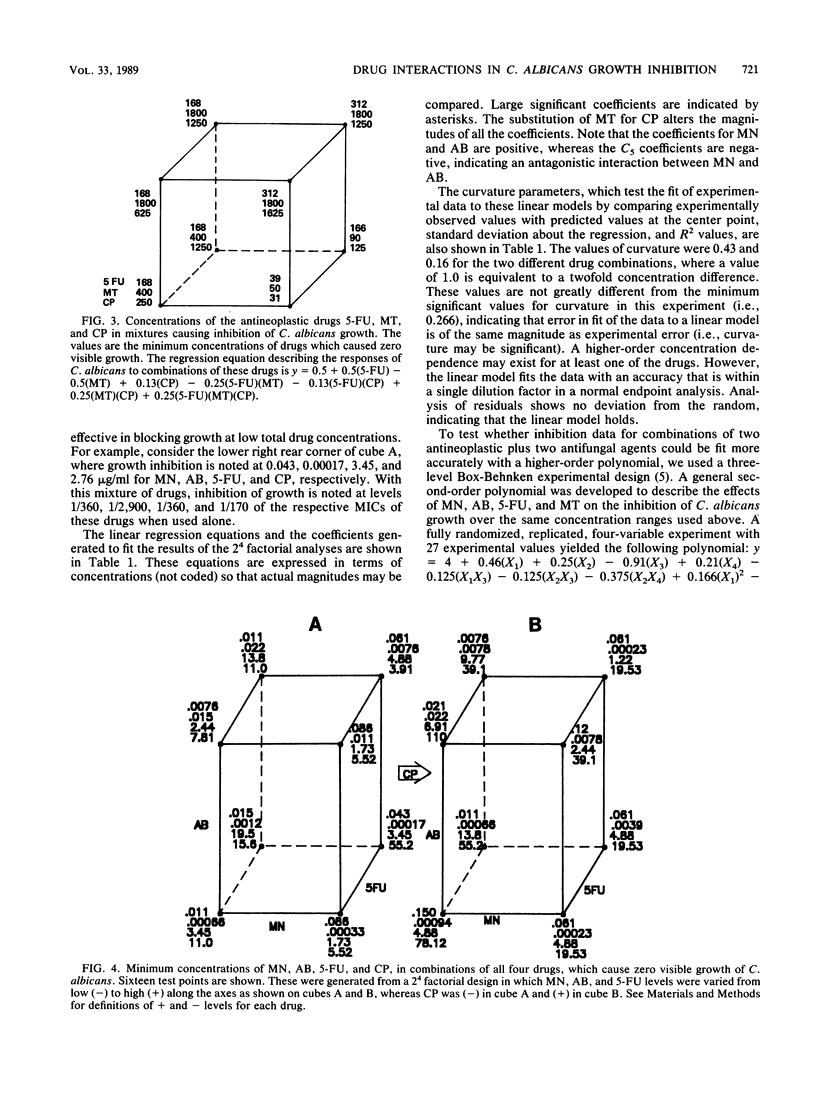
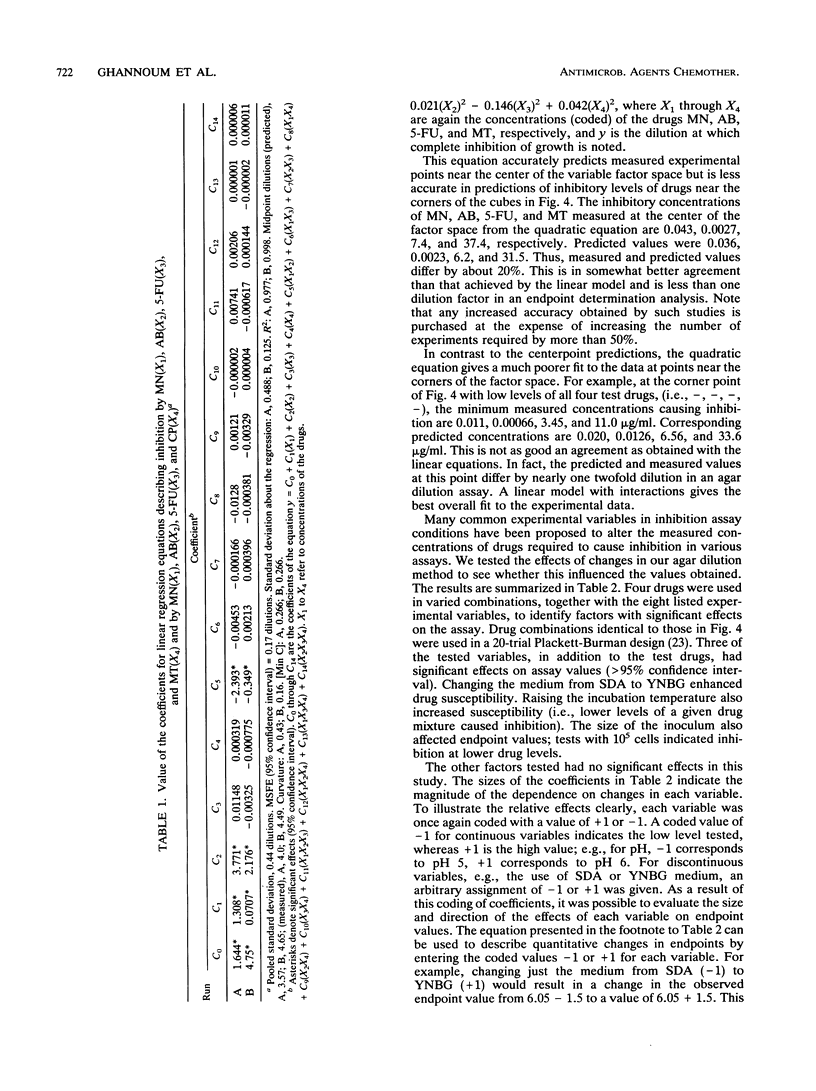
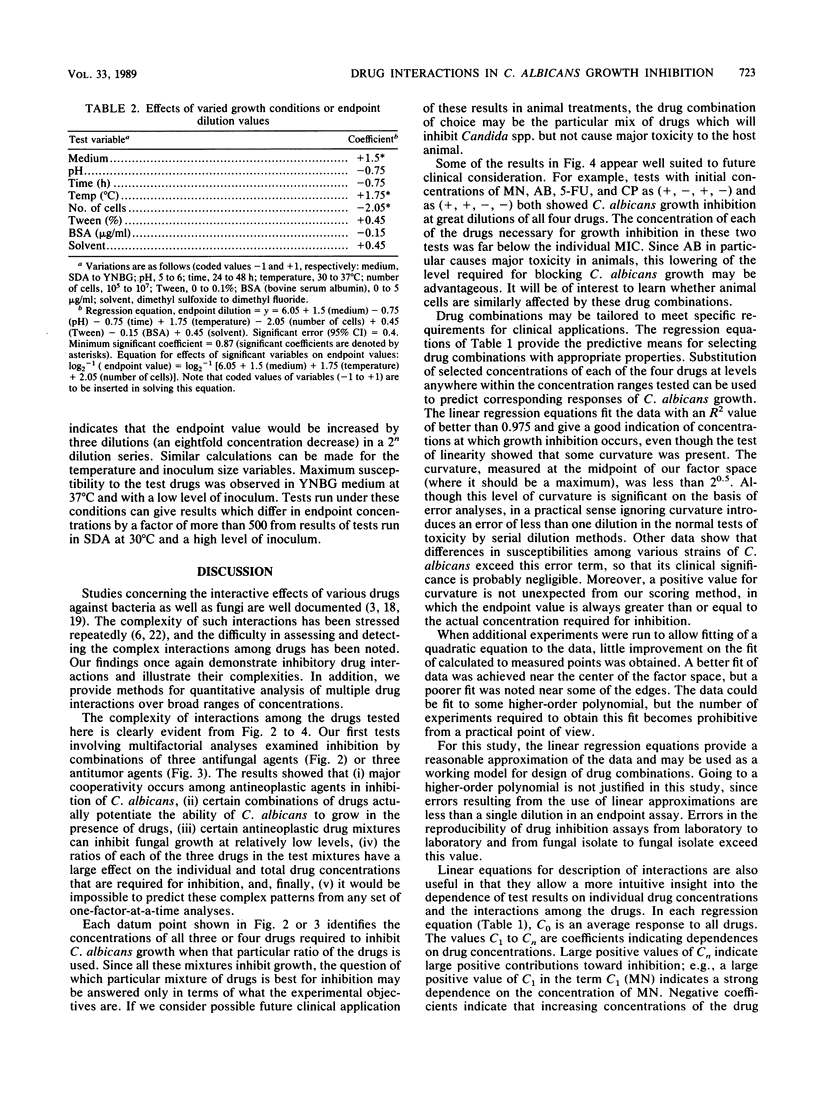
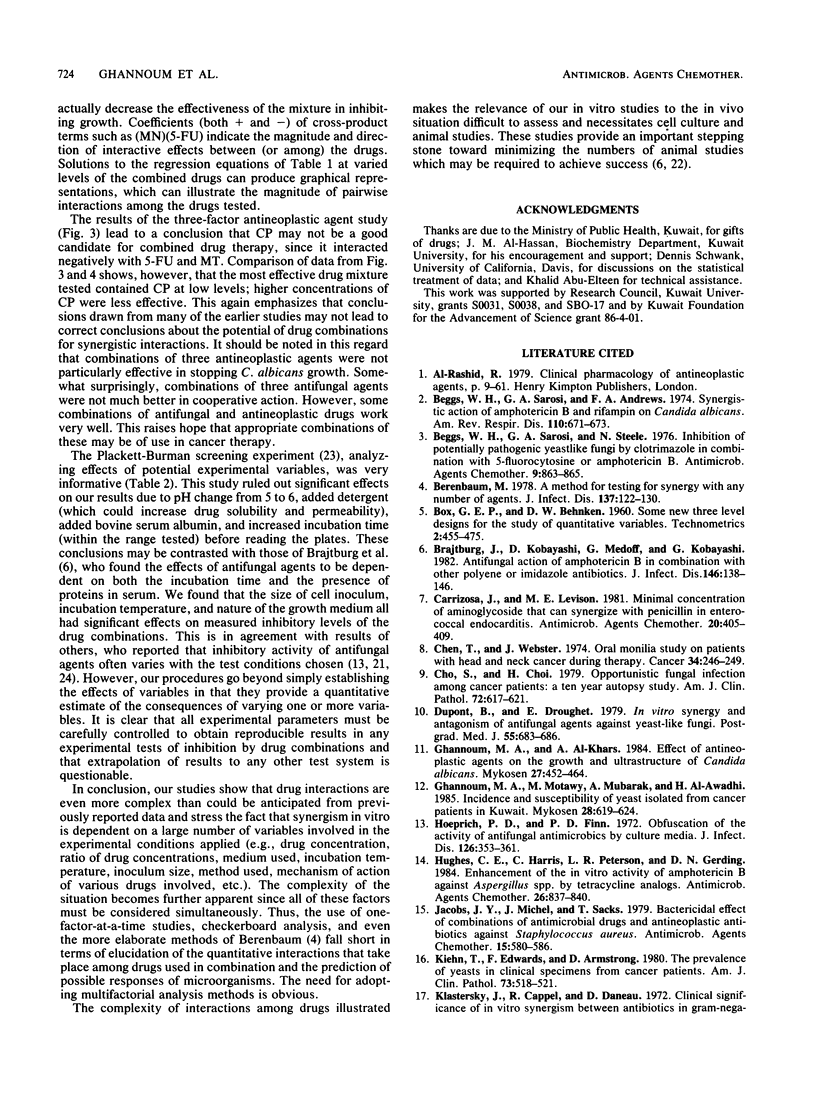
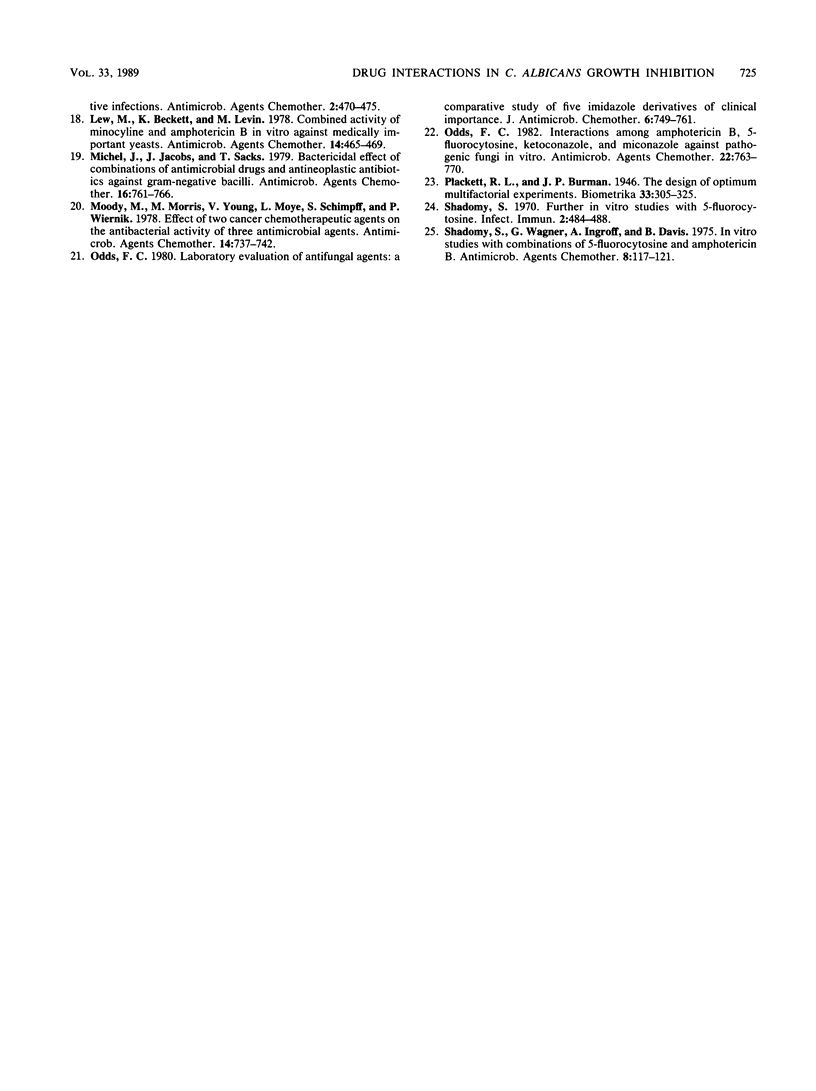
Selected References
These references are in PubMed. This may not be the complete list of references from this article.
- Beggs W. H., Sarosi G. A., Andrews F. A. Synergistic action of amphotericin B and rifampin on Candida albicans. Am Rev Respir Dis. 1974 Nov;110(5):671–673. doi: 10.1164/arrd.1974.110.5.671. [DOI] [PubMed] [Google Scholar]
- Beggs W. H., Sarosi G. A., Steele N. M. Inhibition of potentially pathogenic yeastlike fungi by clotrimazole in combination with 5-fluorocytosine or amphotericin B. Antimicrob Agents Chemother. 1976 Jun;9(6):863–865. doi: 10.1128/aac.9.6.863. [DOI] [PMC free article] [PubMed] [Google Scholar]
- Berenbaum M. C. A method for testing for synergy with any number of agents. J Infect Dis. 1978 Feb;137(2):122–130. doi: 10.1093/infdis/137.2.122. [DOI] [PubMed] [Google Scholar]
- Brajtburg J., Kobayashi D., Medoff G., Kobayashi G. S. Antifungal action of amphotericin B in combination with other polyene or imidazole antibiotics. J Infect Dis. 1982 Aug;146(2):138–146. doi: 10.1093/infdis/146.2.138. [DOI] [PubMed] [Google Scholar]
- Carrizosa J., Levison M. E. Minimal concentrations of aminoglycoside that can synergize with penicillin in enterococcal endocarditis. Antimicrob Agents Chemother. 1981 Sep;20(3):405–409. doi: 10.1128/aac.20.3.405. [DOI] [PMC free article] [PubMed] [Google Scholar]
- Chen T. Y., Webster J. H. Oral monilia study on patients with head and neck cancer during radiotherapy. Cancer. 1974 Aug;34(2):246–249. doi: 10.1002/1097-0142(197408)34:2<246::aid-cncr2820340203>3.0.co;2-j. [DOI] [PubMed] [Google Scholar]
- Cho S. Y., Choi H. Y. Opportunistic fungal infection among cancer patients. A ten-year autopsy study. Am J Clin Pathol. 1979 Oct;72(4):617–621. doi: 10.1093/ajcp/72.4.617. [DOI] [PubMed] [Google Scholar]
- Dupont B., Drouhet E. In vitro synergy and antagonism of antifungal agents against yeast-like fungi. Postgrad Med J. 1979 Sep;55(647):683–686. doi: 10.1136/pgmj.55.647.683. [DOI] [PMC free article] [PubMed] [Google Scholar]
- Ghannoum M. A., Al-Khars A. Effect of antineoplastic agents on the growth and ultrastructure of Candida albicans. Mykosen. 1984 Sep;27(9):452–464. doi: 10.1111/j.1439-0507.1984.tb02060.x. [DOI] [PubMed] [Google Scholar]
- Ghannoum M. A., Motawy M. S., Mubarak A. L., Al-Awadhi H. A. Incidence and susceptibility of yeasts isolated from cancer patients in Kuwait. Mykosen. 1985 Dec;28(12):619–624. [PubMed] [Google Scholar]
- Hoeprich P. D., Finn P. D. Obfuscation of the activity of antifungal antimicrobics by culture media. J Infect Dis. 1972 Oct;126(4):353–361. doi: 10.1093/infdis/126.4.353. [DOI] [PubMed] [Google Scholar]
- Hughes C. E., Harris C., Peterson L. R., Gerding D. N. Enhancement of the in vitro activity of amphotericin B against Aspergillus spp. by tetracycline analogs. Antimicrob Agents Chemother. 1984 Dec;26(6):837–840. doi: 10.1128/aac.26.6.837. [DOI] [PMC free article] [PubMed] [Google Scholar]
- Jacobs J. Y., Michel J., Sacks T. Bactericidal effect of combinations of antimicrobial drugs and antineoplastic antibiotics against Staphylococcus aureus. Antimicrob Agents Chemother. 1979 Apr;15(4):580–586. doi: 10.1128/aac.15.4.580. [DOI] [PMC free article] [PubMed] [Google Scholar]
- Kiehn T. E., Edwards F. F., Armstrong D. The prevalence of yeasts in clinical specimens from cancer patients. Am J Clin Pathol. 1980 Apr;73(4):518–521. doi: 10.1093/ajcp/73.4.518. [DOI] [PubMed] [Google Scholar]
- Klastersky J., Cappel R., Daneau D. Clinical significance of in vitro synergism between antibiotics in gram-negative infections. Antimicrob Agents Chemother. 1972 Dec;2(6):470–475. doi: 10.1128/aac.2.6.470. [DOI] [PMC free article] [PubMed] [Google Scholar]
- Lew M. A., Beckett K. M., Levin M. J. Combined activity of minocycline and amphotericin B in vitro against medically important yeasts. Antimicrob Agents Chemother. 1978 Sep;14(3):465–469. doi: 10.1128/aac.14.3.465. [DOI] [PMC free article] [PubMed] [Google Scholar]
- Michel J., Jacobs J. Y., Sacks T. Bactericidal effect of combinations of antimicrobial drugs and antineoplastic antibiotics against gram-negative bacilli. Antimicrob Agents Chemother. 1979 Dec;16(6):761–766. doi: 10.1128/aac.16.6.761. [DOI] [PMC free article] [PubMed] [Google Scholar]
- Moody M. R., Morris M. J., Young V. M., Moyé L. A., 3rd, Schimpff S. C., Wiernik P. H. Effect of two cancer chemotherapeutic agents on the antibacterial activity of three antimicrobial agents. Antimicrob Agents Chemother. 1978 Nov;14(5):737–742. doi: 10.1128/aac.14.5.737. [DOI] [PMC free article] [PubMed] [Google Scholar]
- Odds F. C. Interactions among amphotericin B, 5-fluorocytosine, ketoconazole, and miconazole against pathogenic fungi in vitro. Antimicrob Agents Chemother. 1982 Nov;22(5):763–770. doi: 10.1128/aac.22.5.763. [DOI] [PMC free article] [PubMed] [Google Scholar]
- Odds F. C. Laboratory evaluation of antifungal agents: a comparative study of five imidazole derivatives of clinical importance. J Antimicrob Chemother. 1980 Nov;6(6):749–761. doi: 10.1093/jac/6.6.749. [DOI] [PubMed] [Google Scholar]
- Shadomy S. Further in vitro studies with 5-fluorocytosine. Infect Immun. 1970 Oct;2(4):484–488. doi: 10.1128/iai.2.4.484-488.1970. [DOI] [PMC free article] [PubMed] [Google Scholar]
- Shadomy S., Wagner G., Espinel-Ingroff E., Davis B. A. In vitro studies with combinations of 5-fluorocytosine and amphotericin B. Antimicrob Agents Chemother. 1975 Aug;8(2):117–121. doi: 10.1128/aac.8.2.117. [DOI] [PMC free article] [PubMed] [Google Scholar]


